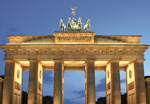 If you are looking for excitement in a European vacation, you can find more than enough on the streets of places like Athens, Madrid, and Moscow these days. However, seeking an interesting but more risk-free destination, we headed for Berlin at the start of a recent trip to Germany.
If you are looking for excitement in a European vacation, you can find more than enough on the streets of places like Athens, Madrid, and Moscow these days. However, seeking an interesting but more risk-free destination, we headed for Berlin at the start of a recent trip to Germany.
By Paul Hicks
 If you are looking for excitement in a European vacation, you can find more than enough on the streets of places like Athens, Madrid, and Moscow these days.
If you are looking for excitement in a European vacation, you can find more than enough on the streets of places like Athens, Madrid, and Moscow these days.
However, seeking an interesting but more risk-free destination, we headed for Berlin at the start of a recent trip to Germany.
Instead of storms of protest and angst found elsewhere on the continent, our visit to Berlin was like being in the eye of a hurricane. The calm was broken only briefly one night by boisterous celebrating all over the city after Germany beat Holland in an early round of the Euro Cup football matches. We had no trouble making dinner reservations as so many Berliners were home watching the televised games.
At the top of what Frommer’s travel guide to Germany deems the best that the country has to offer is: “Exploring the new Berlin…through what used to be the most bitterly contested urban turf in Europe can’t help but provoke powerful emotions.” As background you might want to read “Berlin 1961: Kennedy, Khrushchev, and the Most Dangerous Place on Earth” by Frederick Kempke.
There is still a lot of evidence of the formerly divided city, including the museum at “Checkpoint Charlie”, as well as historical artifacts of World War II, including Hitler’s last bunker and the Holocaust Museum. However, there is also an amazing amount of new development underway all over the city that continues to create the New Berlin. There does not seem to be much austerity in infrastructure spending in the capital.
 Nothing symbolizes the city’s renewal better than its major museums. The Neues Museum, which opened in 2009, is famous for its Egyptian collection, especially the extraordinarily beautiful bust of Queen Nefertiti that dates to 1340 BCE. Close by is the Pergamon Museum, a vast structure that houses memorable antiquities from Greece and Rome as well as ancient Babylon and Persia. Not to be missed are the monumental Pergamon Altar and the Ishtar Gate.
Nothing symbolizes the city’s renewal better than its major museums. The Neues Museum, which opened in 2009, is famous for its Egyptian collection, especially the extraordinarily beautiful bust of Queen Nefertiti that dates to 1340 BCE. Close by is the Pergamon Museum, a vast structure that houses memorable antiquities from Greece and Rome as well as ancient Babylon and Persia. Not to be missed are the monumental Pergamon Altar and the Ishtar Gate.
The Bode Museum, also nearby on what is called Museum Island, and the Gemaldegalerie (Portrait Gallery) round out the top four museums in Berlin. They are all worth visiting even if you see nothing else in the city. A museum pass, costing 19 euros, lasts three days and is a good investment if you are there long enough to see these great collections.
Berlin, one of Europe’s largest cities, is very spread out so choosing your hotel’s location is important. Following a friend’s advice, we stayed at the Hotel Kempinski Bristol, located just off the Kurfurstendam, a main avenue in the western part of the city called “KuDam” by Berliners. Another popular hotel location is the Tiergarten district near the Brandenburg Gate.
The timing of our visit in mid-June was especially fortuitous. Not only were there very few tourists (a sign of the economic times as well as the timing of school vacations), but the city was perfumed sweetly by the blossoms on the linden trees growing everywhere, and not just on the famous boulevard called Unter den Linden.
Friends had told us that Berlin was a child-friendly city, which we confirmed by a delightful trip to the centrally located Berlin Zoo, the oldest in Europe. It is also a city for lovers of classical music. Although the Berlin Philharmonic Orchestra was not performing, we heard a fine program by the German Symphony Orchestra of Berlin in Philharmonic Hall, which, as we can attest, is noted for its acoustics.
If you are looking for old-fashioned German cuisine, like schnitzel and wurst, you will find many sources in Berlin. However, we were also fortunate to be there during the white asparagus season, a gastronomic treat that we were able to savor in soup, salads, and various other dishes.
One of the most enjoyable dining locations turned out to be in a giant department store called Kaufhaus des Westens, known to Berkliners as KaDeWe. It is sort of a cross between Harrods and Fortnum & Mason in London and offers a variety of food and drink choices on two of its eight floors. One is devoted to delicatessen specialties served at numerous counters and the other is a winter garden restaurant.
We have been in no more welcoming city than Berlin. One of our cab drivers said he was from a rural area and did not consider himself a Berliner because he did not move at their fast pace. Another said he came to Berlin because he hailed from a part of the country where the horses were better looking than the women. At dinner one evening, a departing diner turned to us and said, “Enjoy your stay in Germany.” What more can a visitor ask?















